This website uses cookies so that we can provide you with the best user experience possible. Cookie information is stored in your browser and performs functions such as recognising you when you return to our website and helping our team to understand which sections of the website you find most interesting and useful.
Everything you need to know about Brunello di Montalcino’s 2019s
After the recent Brunello di Montalcino En Primeur, Filippo Bartolotta gives a wine-by-wine breakdown of the Tuscan region’s 2019 vintage.
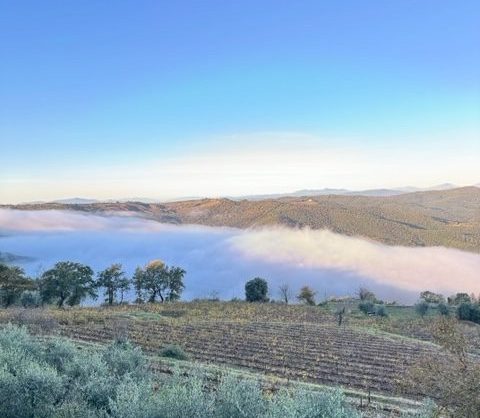
And here we go again with another Brunello di Montalcino En Primeur tasting. This time round was all about the vintage 2019. As you all know, Brunello di Montalcino has to spend at least five years in the cellar before release, so this vintage will arrive on the shelves from February 2024.
Expectations were very high as the vintage seems to have been one of those mighty ones with a hot summer with cool nights and a relatively good amount of rain which helped the geometrically designed vines on the hills surrounding Montalcino, to grow relatively stress free. A few people compared this vintage to the ‘classic’ 2016, which has been so far the best vintage of this century, but if some of the samples were very elegant with a firm structure and with a great ageing potential like ’16, quite a few samples seems closer to the hotter, more ready to drink and generous 2015 vintage. For sure, there was very little resemblance to the scorching 2017 – where many wines seemed to have chosen a body builder carrier – or to the linear, athletic structure of the rainy 2018 vintage.
What I love particularly about 2019 is the combination of generous aromatics, supple fruit, with a delightful juiciness and an important structure to keep the wines for your kid’s 18th birthday! So, overall, a very good vintage which sometimes showed a little too much alcoholic exuberance but with a great future: the wines seem to show a very direct link to their place of origin. I am not talking necessarily of a specific hill or vineyard but rather a larger area. As a matter of fact, Montalcino wines can be split into four main quadrants: North West, North East, South West, South East.
View this post on Instagram
On a side note, when talking about Brunello di Montalcino there are three main factors which also contribute to the quality of these wines.
- Altitude. A paramount factor as Sangiovese in Montalcino can go between 200 and almost 600 metres above the seal level. The higher a vinegar is the lighter the color of the wine, the more acidic the wines and the later the ripening process (which often means enjoying the cooler nights resulting into fresher aromatics).
- Wind. Montalcino is always windy. It’s a hilltop village exposed to the cool northern winds and the mild southwest sea breeze. These air circulation is a balm against mildews and a magic wand for rainy vintages like 2018, when a few days before what was looking like a very gloomy wet harvest, the strong dry winds literally dried all Sangiovese out and the vintage was saved!
- Soil composition. Most of Montalcino is a marl with more or less active calcareous presence and in the southern parts also sandier. In a nutshell: clay based soil bring body and longevity, sandy driven soils, explosive aromatics and readier tannins, the schist clay with calcar bring minerality and salinity in the wines.
So now let’s take a look at the four quadrants and at some of the more interesting interpreters of this vintage, keeping in mind that around 30 wineries usually present at the En Primeur didn’t show up this year.
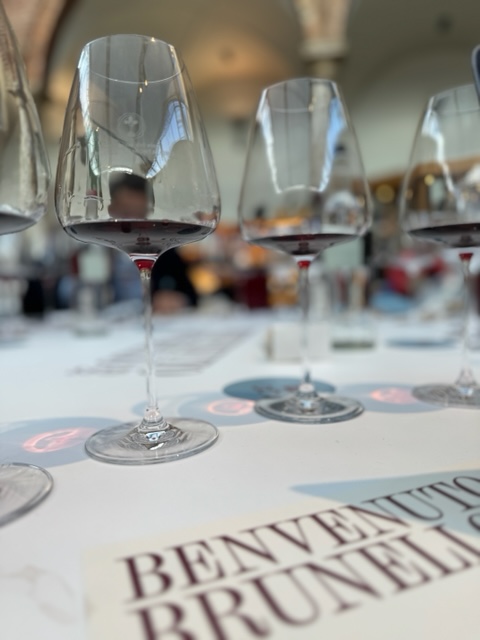
North and North East
The northern reaches of the denomination gave the greatest number of top-notch wines in 2019, expressing stylistic and geographic diversity while sharing finesse and tension as a common point. These wines tend to display a pure and elegant expression of fruit – raspberry, sour cherry, blood orange or pomegranate – intertwined with dry balsam herbs, minerals, a touch of gaminess, and sometimes an alluring whiff of exotic spice.
Starting from the northernmost corner of Montalcino, the windswept slopes of the Montosoli hill appear on the right when entering the township from the road that connects Montalcino to Siena. This vineyard has earned a reputation as one of the best sites for Brunello production. The ‘Schiena d’asino’ (donkey-back) shape and peculiar soils consisting of a mix of dark clay and alluvial deposits allow to achieve optimal ripeness and great palate depth while retaining lively aromatics and high acidity. In this vintage, Caparzo’s La Casa, one of the most iconic wines from Montosoli, is a real stunner, displaying the unique, almost exotic character of the Cru – dare we call it a Burgundy-reminiscent Brunello?
By contrast, Vigna Montosoli by Canalicchio di Sopra needs a bit more time to shed some of its tannic heft – but even in this case the aromatics are downright terrific!
Moving about two kilometres south and crossing the Suga River, the northeastern quadrant of the denomination, which lies right below the town and enjoys picture-perfect views over the clay-rich rolling hills of Val d’Orcia, boasts an impressive concentration of small to medium-size producers who made excellent wines in 2019. While racy acidity is always a key element – allowing the wines to be among the few that draw parallels to the highly praised 2016 Brunello – heterogeneous geology results in high variability: the soils range from stony and calcareous uphill to considerably more clayey as you move further east.
Different winemaking approaches further emphasise stylistic diversity. For example, the wines of Franco Pacenti, Ridolfi, Fuligni, Renieri and San Filippo are velvety, expressive, and also, but not exclusively, suitable for short or medium-term consumption, while those by Capanna and Salvioni mix similar finesse with a slightly tighter and edgier palate, requiring a bit of cellaring or a juicy bistecca alla Fiorentina to show best.
Another extremely important area that fits in the Northeastern quadrant is the succession of steep hills stretching to the immediate south of the town of Montalcino. With a dominant position on the valley, this section of the denomination is the historical cradle of Brunello di Montalcino: it includes the poderi (estates) of ancient dynasties like Barbi Colombini and Biondi Santi, who take credits for conceiving the wine as we know it, and stretches all the way down to Gianni Brunelli’s Chiuse di Sotto, the vineyards of which, in our view, mark the border between the two quadrants on the eastern side.
With a soil rich in compacted schist clay and pietraforte (calcareous sandstone), and elevations ranging between 400 and 500 metres, these wines rank among Montalcino’s most powerful and austere – starting out very discreet, then blossoming over time. A recently tasted 1988 Biondi Santi Riserva proved their long-term potential: given how racy and energetic it still tastes, it comes as no surprise that the 2019 Biondi Santi Annata will not hit the shelves before 2025, and the Riserva will be held back for even longer.
Gianni Brunelli’s 2019 also stands out: with the vineyards facing the southeastern sector and overlooking Mount Amiata, the wine only shows a touch more richness, but still highlights the tannic verve and firmness of Brunello from the north.
Caparzo – La Casa
Seductive raspberries and pomegranate mingling with violets, sandalwood, a hint of iron and a kick of exotic spice. So pure and energetic, conveying a sense of uncommon elegance through its seamless flow of crunchy red and black fruits, balsam herbs, and minerals. Well-integrated tannins support the long and polished finish.
Gianni Brunelli – Le Chiuse di Sotto
Deep and layered, with hints of freshly picked bramble fruits beneath a veil of woody, earthy and balsamic aromas. Violets and dark spice also emerge with airing. You get extra richness and creaminess on the back-end yet piercing acidity and well-extracted tannins make for a beautifully poised and classically racy progression, culminating in a long and refined finish.
Franco Pacenti – Rosildo
Staggeringly perfumed, showing watermelon jelly and exotic flowers, followed by botanical herbs and undergrowth. Approachable yet possessing enough inner energy to perform well in the long run. Blood orange and pinpoint tannins underpin the long and beautifully poised progression.
Salvioni
Old-school smokiness and gaminess mingles with pomegranate, balsam herbs, and dark spice. Classically-styled, with imposing but well-managed tannins taking centre stage, backboned by crunchy dark fruits and just a touch of compelling earthiness. Really deep and complex, this is a wine built for the long haul.
Canalicchio di Sopra – Vigna Montosoli
The aromas are downright intoxicating: sandalwood, oriental spice, coffee, and the purest red fruits and florals in the background. Youthfully imposing tannins and crisp acidity frame sour cherries and pomegranate, resulting in the mouthfeel being more austere and tightly-wound than the nose would suggest. Still, this is a lovely rendition of Montosoli that will evolve gracefully.
Capanna
Dark cherries and blackberries give way to anise, liquorice, and a whiff of roasted coffee. Relatively broad yet showing excellent acidity that keeps the solid structure in check. Youthfully clenching tannins make for an austere but poised finish featuring succulent bramble fruits and a savoury tang.
Fuligni
Airy violets and sour cherries with a botanical and bitter orange edge – almost Negroni-like. Deceptively pliant, with sucrose red fruits camouflaging the solid tannic structure. Elegant and polished, it will drink well straight out of the gate yet also possesses enough flesh and mid-palate structure to age beautifully.
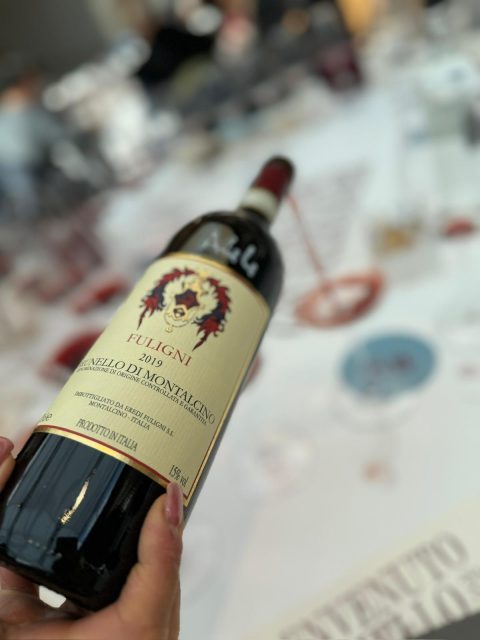
Renieri
Sweet red fruits mingling with exotic florals, eucalyptus, and a hint of wet earth. So suave and accessible: bright acidity is allied to a refreshing herbal/balsamic tang, which lifts the solid core of ripe red fruits and extends the long and predominantly floral finish. An approachable wine emphasizing finesse rather than power.
Ridolfi
Seductive raspberries and bitter orange intertwined with menthol, pot-pourri, and leather. At once graceful and deep, with dusty tannins backing the seductive flow of violets, strawberries, and blood orange. Pure and light on its feet, the long finish featuring tart berries and blood orange.
Casanova di Neri
The peculiar style of the producer is on full display: while being the most traditional among Casanova di Neri’s offerings, it still shows a dark and powerful profile, with sweet blackberries, animal musk and dark chocolate followed by similar flavours. Excellent acidity cuts through the palate-staining layers of dark fruit, leading to a long and youthfully powdery finish.
Castello Tricerchi
Immediately-appealing red cherries mingle with leather and dark spice. Supple and velvety, well-integrated tannins calibrate a mouthful of ripe and luscious red fruits. A great Brunello for short and medium-term consumption.
Donatella Cinelli Colombini – Prime Donne
Subdued and balsamic: liquorice, cola, violets and a hint of damp earth emerge with airing. Crisp acidity and velvety tannins underpin the medium-bodied palate, lingering on the long and polished finish.
Fattoria dei Barbi – Vigna del Fiore
Youthfully reticent, with herbal nuances underpinning tart dark berries and violets. Similarly austere on the palate, with powdery tannins and bright acidity upfront, it has the right credentials to perform well in the long run.
Gorelli
Wet earth laced with ripe red fruits, leather, and pot-pourri. Very classically-styled with racy tannins currently superimposing sour cherry and undergrowth. Tobacco and tar echo on the savoury finish.
Patrizia Cencioni – Ofelio
Attractively dark, with whiffs of roasted coffee and smoke complicating crunchy blackberries, liquorice, and wet earth. Quite brooding on the palate, yet the acidity is vibrant enough to support the full structure and provide lift. Liquorice and minerals echo on the medium-long finish.
North West
On the western side of the town of Montalcino, you will find a radically different landscape – verdant mountains instead of the naked hills topped by cypresses of Val d’Orcia, with few vineyards in sight, mostly interspersed among the woods.
This quadrant is one of the least explored yet gives a few distinctive wines. Immediately to the west of the town, the holdings of L’Aietta, Pietroso, Tiezzi and Colleoni may be considered Montalcino’s urban vineyards. The parcels of the latter producer were originally part of the estate owned by Riccardo Paccagnini, a forsaken pioneer of Brunello in the late 19th century.
Unfortunately, other terraced areas where Paccagnini used to farm vines still need to be rescued, as dramatic slopes have long discouraged investments from larger landowners. In recent times, however, the area as a whole has been on the rise: Vigna Soccorso by Tiezzi, from alberello-trained vines planted to old massal selections, has achieved cult status among the estimators of low-intervention wines while still remaining relatively affordable. In 2019, it shows a touch of tertiary evolution deriving from the hyper-traditional winemaking style, but also plenty of long-lasting energy.
The 2019 Pietroso also shines for its mid-weight and perfumed style – although it is not a pure expression of this quadrant, some of the fruit being sourced from holdings in the Northeastern sector.
Few estates are seen beyond the valley that divides Montalcino from the high hills in the west: wineries on the sides of the SP103 road such as Castello Romitorio, Corte Pavone, Sanlorenzo, Castiglion del Bosco and Tenute Silvio Nardi represent the extreme western frontier of viticulture in Montalcino, some of their parcels being completely surrounded by woods. While specific stylistic choices have resulted in a few of these wines often tasting richer and riper than one would expect, recent vintages show greater emphasis on finesse, with even crisper acidity than examples than the Northeast, tighter tannins, and slightly darker aromas veering towards black fruits.
Pietroso
Iron and animal musk complicate freshly picked red cherries, menthol, and anise. It is bright and inviting, with laser-like acidity allied to fragrant red fruits and edgy tannins. Bright and elegant without being too tight.
Sanlorenzo
Suave and perfumed, focusing on violets, raspberries, and anise. The mid-weight, acidity-driven and youthfully racy palate clearly hints at its provenance from high-altitude vineyards (around 500m). Elegant and pure – if still very tight – it finishes with resonating flavours of balsam herbs and hard candy.
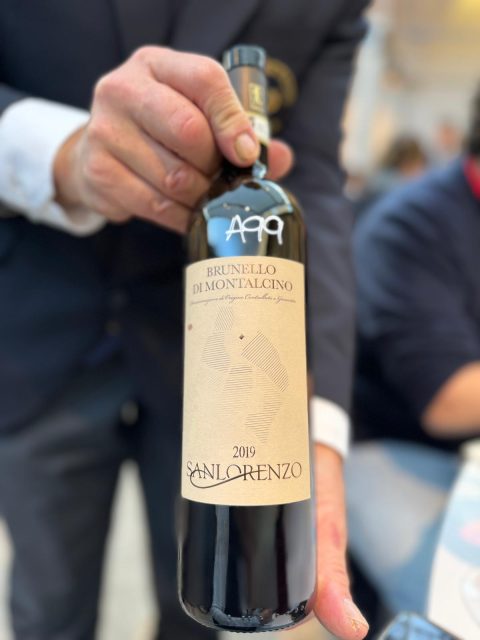
Tiezzi – Vigna Soccorso
Leather, iron and forest floor progressively give way to seductive red cherries and pot-pourri. The palate is equally charming, with savoury blood orange underpinning sweet cherry and creme de cassis, while a touch of earthy evolution complicates the slightly powdery finish. Captivating right now but also cellar-worthy.
Castello Romitorio – Filo di Seta
Extremely shy right now, with subdued nuances of violets and crunchy blackberries beneath a veil of cocoa powder. The palate is equally tight but promising, with seductive florals and a lick of balsamic oak complicating the energetic, acidity-driven progression.
Castiglion del Bosco – Campo del Drago
Dark and earthy, with roasted coffee and elderflower superimposing sweet blackberries and violets. Broad and velvety, it feels a bit creamier and more immediately-appealing than other wines from this area but still retains excellent poise, thanks to lively acidity and perfectly integrated tannins.
Corte Pavone – Fiore di Meliloto
Iron, menthol, and just a hint of spicy oak camouflaging the tart bramble fruits. Focusing on finesse rather than power, it feels very graceful and ethereal, with crisp acidity energizing the mid-weight progression, menthol and liquorice extending the suave finish.
Tenute Silvio Nardi – Poggio Doria
Distinctive red apple and lavender mingle with woody undertones. Dusty tannins outweigh the fruit at this stage, leaving an impression of dryness on medium-long finish. It may improve with a little bottle aging.
South East
Passo del Lume Spento, ;the passage of the mulled light’. With a name that sounds as it was taken from a Tolkien novel, this area to the south of the town of Montalcino is commonly considered one of the borders between the northern and southern sector of the denomination. Peaking at 700m, it is also the highest point in the township – historically not considered suitable for quality wine production, its potential has been reassessed in the face of global warming, with big players like Antinori and Santa Restituta (Gaja) having invested in nearby vineyards. While pure expressions of this terroir, such as the namesake wine by Le Ragnaie, are quite elusive, the wines made in the immediate surroundings proved solid in 2019. A recently established project by the Franceschi family of Il Poggione Fame, La Casaccia made an especially promising Brunello from a plot lying at 450-480m, completely surrounded by woods. This is an unusual setting for the southeastern sector of Montalcino – mostly seen in the Northwest – and the wine is just as distinctive as the place itself.
A cluster of high-achieving wineries lies to the east of the Passo del Lume Spento, and just to the south of Le Chiuse di Sotto. To the east of the SP55 road, which takes you down to the southeastern reaches of the denomination, San Polo, Le Macioche and San Polino produced especially attractive wines: redolent of sweet red fruits complicated by sexy florals and exotic spice, anticipating an approachable and finessed palate with good acidity to balance.
Going further south, Castelnuovo dell’Abate takes visitors’ breath away with its picture-perfect views of vineyards and rural houses against the backdrop of Monte Amiata. A landmark monument, the medieval abbey of Sant’Antimo sits at the bottom of the valley that houses the charming small town. Estates on the surrounding slopes are among Montalcino’s most revered.
The cooling effect deriving from the proximity to Mount Amiata compensates warm daytime temperatures with considerably cooler nights, normally resulting in big and beefy wines that still retain excellent balance – the red fruit richness matched by substantial tannins and ripe acidity.
While the most ambitious 2019s from this area – such as Poggio di Sotto – display this enthralling combination of power and energy, the least successful examples show darker-than-usual fruit and feel a bit warm and drying on the finish.
To the west of Castelnuovo dell’Abate, Sant’Angelo in Colle houses one of the largest concentrations of vineyards in the denomination, mostly lying on gently sloping hills with soils rich in alberese (grey limestone) and galestro. Brunellos from this area tend to be even richer than those from Castelnuovo dell’Abate. While always generous and accessible, the remarkable fruit-acids-tannin balance allows them to perform well in the long run – older vintages by Col d’Orcia, such as the spectacular Poggio al Vento 1990, are case in point.
Exactly like Castelnuovo dell’Abate, this area proved less consistent in 2019 than in top vintages like 2015 and 2016. However, it offers a good number of solid wines – including the 2019 Col d’Orcia. Slightly riper and more fruit-forward than in the best vintages, this large-production Brunello will drink well straight out of the gate.
Anyways, the real star of the vintage in Sant’Angelo in Colle is Giodo: world-famous winemaker Carlo Ferrini has risen to fame for making hyper-concentrated wines, yet his daughter Bianca seems to pursue a diametrically opposite style at this estate: the Pinot-esque purity of Giodo is almost anomalous. Not only this is the best vintage this young – if wildly successful – winery has ever made: it epitomizes a completely new style of Brunello. While those who are accustomed to traditionally austere and earthy versions might not be especially fond of its early-appealing, polished and fruit-forward identity, enthusiasts of refined, Burgundy-inspired reds will find a lot to like.
Giodo
Incredibly pure and airy: raspberries and red roses mingle with lavender, sandalwood, and oriental spice. Mid-weight and silky, it displays a seductive core of sucrose red and blue fruits, with almost Pinot-esque finesse and blood orange crispness on the back-end. Pinpoint tannins caress the seamless progression, and support the long finish featuring botanical herbs and the slightest hint of oak spice.
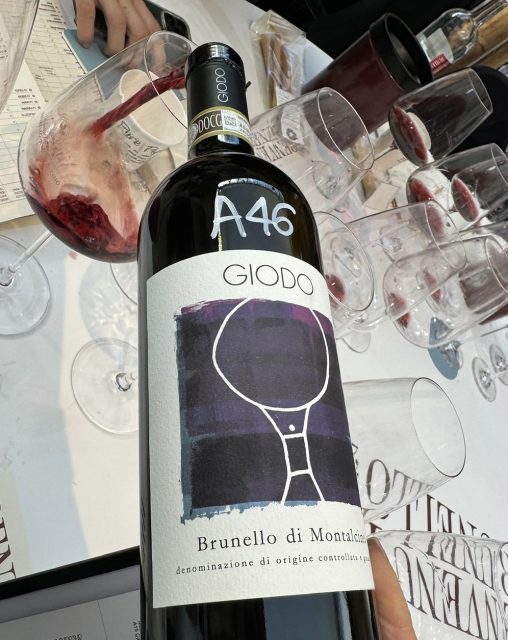
Poggio di Sotto
Grilled herbs, smoke and animal musk match lighter shades of sour cherries and potpourri. Slightly austere in this phase, imposing tannins and savoury minerals camouflage the typical red-fruited richness of Brunello from Castelnuovo dell’Abate. Still, it shows lovely grip and poise, with a refreshing blood orange tang and subtle earthiness extending the “chiaroscuro” finish. Built for the long haul.
Casanova di Neri – Tenuta Nuova
This unmistakably modern, barrel-aged Brunello shows a relatively dark color that anticipates exuberant aromas of plums and violets mingling with cocoa powder, menthol, graphite, and dark spice. Broad-shouldered and velvety, excellent acidity lifts the decadent – but not jammy – red fruits to the core, while a lick of creamy oak rounds the edges of the seamless progression, finishing long and slightly tarry.
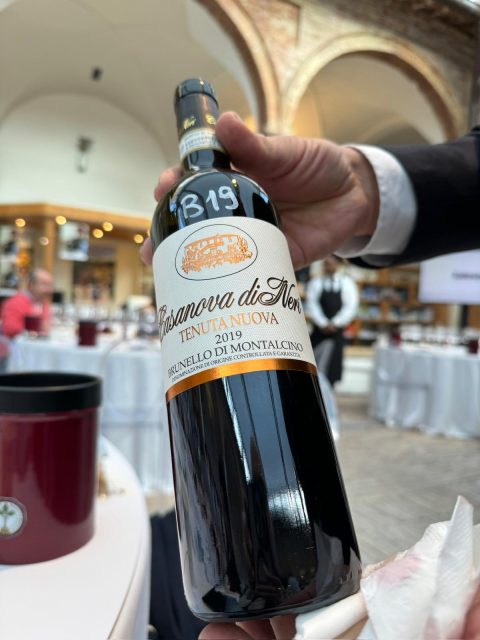
La Casaccia di Franceschi
Dark and captivating: balsamic nuances anticipate blackberries, violets, and a captivating whiff of black truffle. Classically earthy and slightly smoky but also slim and bright, with crunchy bramble fruits upfront, and a herbal twist refreshing the savoury finish.
Mastrojanni – Vigna Loreto
Sweet raspberries and creme de cassis give way to iron, cigar ash and Mediterranean herbs, shaping a textbook Castelnuovo dell’Abate nose. Similar flavours echo on the palate, with an underlying kick of bitter orange keeping everything in check and well-integrated tannins framing the long, iron-tinged finish.
Talenti – Piero
Dark and deep, gamey and earthy aromas camouflage the fragrant black and red fruits, anticipating an equally rich mouthfeel exuding the power of Sant’Angelo in Colle without feeling too heavy. Youthfully gripping tannins support the long finish featuring dusty minerals and excellent acidity to balance.
Casisano
Plums, cherries and a vibrant balsamic edge. An elegant nose with some cold spices and a warm, fruit-driven character. Very well integrated tannins with some intense earthiness and an old school Tuscan flair.
Collemattoni
Iron and balsam herbs complicate the attractive red fruits. Structured and classically gripping on the palate, with zesty herbs and blood orange underlying luscious red cherry, hints of damp earth and seasoned wood extending the long and racy finish.
Ciacci Piccolomini d’ Aragona – Pianrosso
A bit closed in this phase, with smoke and iron superimposing freshly picked red fruits. Blood orange and racy tannins take center stage on the palate, making for a promising – if slightly austere – progression. Give it time to gain greater aromatic breadth.
La Magia – Ciliegio
Quite modern, showing only the slightest hint of earthiness beneath red roses, plum, and sweet spice. Pinpoint tannins belie the rich core of red fruits, making for a juicy and polished mouthfeel with a velvety and balsamic finish. Perfect for medium-term consumption.
Le Macioche
Rosemary and white pepper amplify dark cherries and violets. Poised and approachable, with seamless tannins supporting the medium to full structure, well-integrated acids and a savoury tang linger on the long and focused finish.
San Polo – Podernovi
Charmingly perfumed: watermelon jelly, botanical herbs and pot-pourri give it an almost Pinot-esque allure. Super bright and fresh, it isn’t the deepest wine in show, yet shows excellent refinement and focus, with refreshing acids supporting the mid-weight core of luscious red fruits and extending the long finish.
San Polino – Helichrysum
Seductive and immediately-pleasing: whiffs of balsam herbs, dark spice and toast complicate red cherries and pot-pourri. A mouthful of sucrose red fruits follows up on the palate, shaping a luscious and open-knit mouthfeel with great acidity to balance and assertive tannins lifting to the long, balsamic finish.
Uccelliera
Dark cherry mingles with tobacco, grilled herbs, and a whiff of damp earth. Classically-styled with ripe acidity and well-integrated underpinning the solid structure, sour cherry and smoke echoing on the long finish.
Ciacci Piccolomini d’Aragona
More immediately-appealing than Pianrosso, with wild fennel and anise over sweet red fruits. Approachable and moderately warm, ripe acidity lifts the voluptuous red fruits and lingers on the slightly dusty finish.
Col d’Orcia
Pretty aromas of wild strawberries and red cherries allied to liquorice, violets, and oregano. Equally finessed on the palate – not the last word in complexity yet the combination of immediately-pleasing red fruits and ripe acidity is very attractive. Dried herbs linger on the medium-long finish.
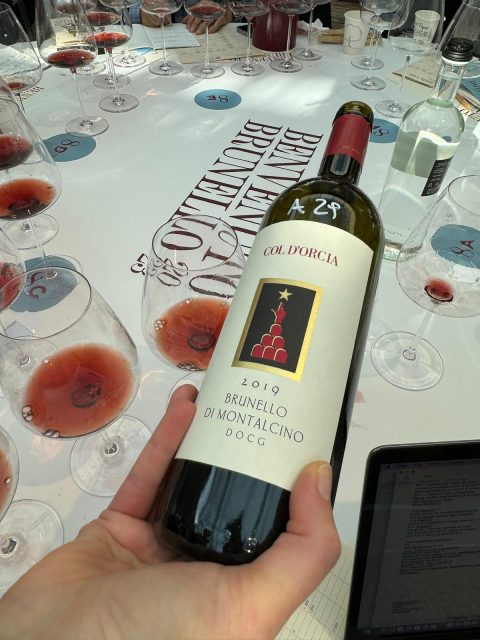
Il Poggione
Old-school earthiness and gaminess outweighs the black fruits, anticipating a robust palate with just a touch of tertiary evolution, assertive tannins, and a savoury tang balancing the slightly warm and smoky finish.
La Fiorita – Fiore di No
Blackberries and florals mingle with wet earth, leather, and cocoa powder. Approachable and inviting on the palate, with a creamy structure energised by judicious acids and well-integrated tannins. Dried herbs linger on the medium-long finish.
Tenuta Buon Tempo
Dark cherry and leather mingle with briny and herbal touches. Similar on the palate, with an earthy edge to the understated red fruits, racy tannins, and good acidity lifting the medium-long finish.
South West
As you head southwest from the Passo del Lume Spento, you will find rolling hills that gently degrade towards Maremma – from their top you can often spot the Tyrrhenian Sea on the horizon.
The luminosity in this area is almost dazzling: together with maritime influence, it shapes wines with a distinctive Mediterranean allure, including the few very successful Supertuscans from Montalcino.
Along the Strada di Argiano, the area of Tavernelle houses a cluster of small to medium-size wineries that punch well above their size: Case Basse di Soldera Gaja’s Pieve Restituta, Fattoi and Caprili among others. Soils rich in alberese and relatively high altitudes – often above 450m – allowed the production of excellent Brunellos in 2019, boasting captivating Mediterranean exuberance while also highlighting stylistic diversity. Deceptively enjoyable in their youth, they will also age well.
To the north and south of Tavernelle, you will find some of the largest and most historical estates in Montalcino. With a history dating back to the middle Ages, Argiano is on the rise again under the helm of Brazilian entrepreneur Andrè Esteves. Following the high-achieving 2018, the 2019 Argiano is another great accomplishment.
Lying to the north, flanked by woods on most sides, the Castelgiocondo estate of the Frescobaldi family covers a whopping 190 hectares. It also incorporates Tenuta Luce, the vineyards of which are devoted to the production of the namesake Supertuscan and Brunello di Montalcino.
Further west, the vineyards of Camigliano, an enchanting small village turned into one of Montalcino’s most renowned wineries, flank the Ombrone river, which marks the western border of the denomination. While in some of the warmest vintages of the last decades the wines made here showed excess heat and dryness, with leathery and spicy flavours outweighing the fruit, the 2019s proved impeccably balanced: good acidity calibrates calibrates the solid structure and aromatic exuberance you would expect from one of the warmest areas in Montalcino.
Last but not least, the holdings of Castello Banfi occupy the southernmost corner of this sector, descending towards the Orcia river. Covering almost 200 hectares, Banfi is one of Italy’s most famous wine brands. The Mariani-May family and their historic winemaker, Ezio Rivella, take credits for having paved the way for the rise of Brunello di Montalcino from the 1970s onwards.
With over 500,000 bottles produced on an average year, the entry-level Banfi Brunello di Montalcino enjoys stellar commercial success, and the 2019 is a good effort. On other hand, 2019 Vigna Marrucheto is an especially captivating rendition, standing out for its overall poise while still embodying Banfi’s signature style focusing on richness and immediate appeal.
Caprili
From the Tavernelle/Santa Restituta area, it shows lovely freshness: strawberry and pomegranate lead the scene, followed by blood orange, dried herbs, and just a touch of undergrowth. Equally pure and bright on the palate, sharp acids energize the medium to full structure, with sucrose red fruits to the core, and just a touch of tannic dustiness in the background, making for a distinctive expression of this terroir that retains exceptional balance and focus.
Argiano
Expressive and inviting, a kiss of oak spice frames pure red cherries giving way to liquorice and zesty herbs. Seductively open-knit, the medium-bodied core of luscious red fruits backboned by a blood orange tang, it finishes long and savoury.
Banfi – Vigna Marrucheto
Brooding and powerful, with wafts of smoke and undergrowth framing anise, capers, blackberries, and violets. Broad and creamy, it retains good balance thanks to lively acidity, substantial tannins, and enticing herbal and spicy elements gaining prominence on the long finish.
Camigliano – Paesaggio Inatteso
Red and black fruits beneath layers of spice, herbs and animal nuances convey a specific sense of place. Bold and smoky but not too heavy, well-integrated tannins support the substantial structure along with savoury minerals, loosening their grip in a long, garrigue-scented finish.
Fattoi
Briny and animal, the red and black fruits hidden under a veil of damp earth and garrigue. Classically-styled with imposing tannins progressively giving way to dark fruits and spice, and a long, smoky finish.
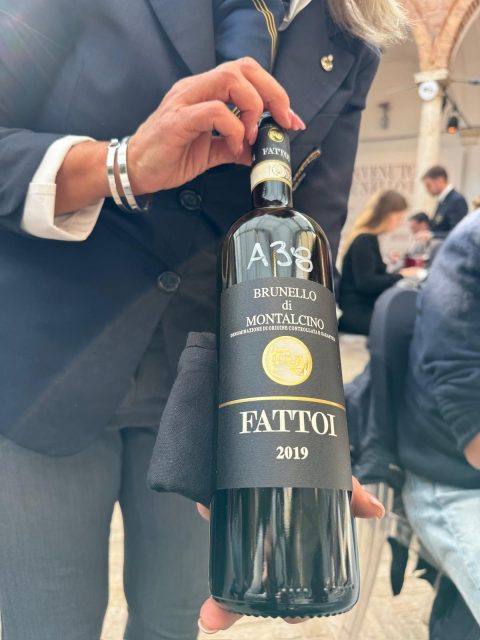
Camigliano
Blood orange, oregano, paprika and a whiff of smoke make for an expressive nose, anticipating an attractive palate with just a touch of underlying powderiness, and good fruit-acids balance fostering approachability. Spicy herbs linger on the medium-long finish.
Elia Palazzesi
Red cherries over zesty herbs, tapenade, and dark spice. Medium-bodied and approachable, the gamey and spicy contours to the mid-weight structure remark the provenance from sun-kissed vineyards but the fruit and acidity are bright enough to give it plenty of early-drink appeal.
Mocali – Le Raunate
From vineyards nearby Tavernelle, it focuses on Mediterranean herbs, sweet raspberries and violets, with earthy and woody aromas echoing in the background. Slightly fruitier on the palate, displaying ripe red fruits on a bed of slightly dusty tannins, a herbal twist extends the medium-long finish.
Sesti
Very expressive, with a touch of tertiary evolution underpinning sweet cherries, anise, and cocoa powder. It enters ample and fruit-forward, then turns more tannic and fresher towards the medium-long finish showing a touch of alcoholic heat.
Banfi
Textbook earthiness and dried herbs superimposed onto dark cherries, with toasted oak and tar. Linear on the palate: slightly astringent tannins backbone an open-knit progression focusing on creamy dark fruits and finishing with smoky and herbal flavours.
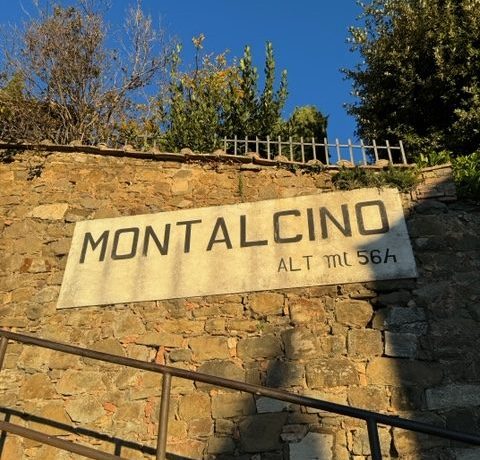
Related reading:
Kellerei Bozen TAL: two new icons from Alto Adige
Barolo en primeur 2023: ‘wine solidarity knows no boundaries’
Related news
Glenfiddich becomes official partner of Aston Martin F1 team
Spain 'needs to learn how to market our fine wines', producer claims
Bourgogne wine see global growth despite difficult market conditions

